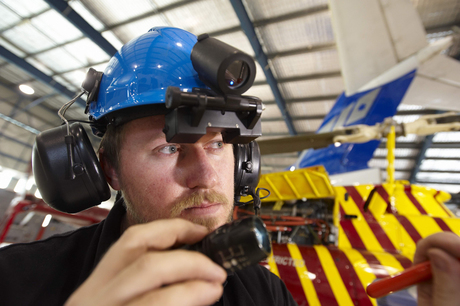Australian aerospace company to commercialise CSIRO's wearable tech system

CSIRO and Australian aerospace company TAE have signed a licensing agreement to commercialise CSIRO’s Guardian Mentor Remote (GMR) wearable technology system and make it available to the global aerospace industry.
The new wearable technology can remotely connect technicians with aviation experts from around the world and will allow commercial, regional and defence aircraft operators to reduce aircraft downtime and maintenance costs.
GMR is hands-free technology that uses a headset and glasses to connect experts with on-site operators so they can provide real-time assistance. This means companies can undertake aircraft and engine repairs and maintenance without having to fly in specialist engineers or mechanics.
According to Andrew Sanderson, managing director of TAE, the technology has huge potential to bring down maintenance costs for airlines, particularly those in regional locations. “In the aerospace industry, costs associated with aircraft downtime are a critical issue,” Sanderson said.
“If a plane’s not operational, it can cost a company up to $12,000 per hour. Therefore, any technology that makes maintenance easier and helps bring down repair times is a valuable investment.
“Using the GMR system, it is just like the expert is in the room with you, even if they’re in another state or even another country.
“That means ... no more waiting days to get aircraft back up and running.”
The GMR system consists of a helper station and an operator station, which both use a wearable computer with a helmet-mounted camera and a near-eye display.
The display provides a shared visual space, allowing the off-site expert to demonstrate what needs to be done using a pair of virtual hands.
According to Dr Marcel Bick from CSIRO’s Manufacturing Flagship, it’s technologies like GMR that are helping Australian companies create more intelligent industrial environments.
“Robotic and digital solutions are improving operating safety and efficiency for Australian industry. As we have increased access to high-speed broadband, this makes the possibilities even more exciting,” Dr Bick said.
“The GMR prototype has already been trialled by Boeing and Aviation Australia. With TAE commercialising the technology, from later this year it will be available to aerospace companies around the world.”
As well as boosting efficiency in the aerospace industry, GMR could also be used for a range of other applications.
“We see huge potential for GMR in a number of settings including the general manufacturing, mining, automotive, paper and pulp and rail industries,” Dr Bick said.
“It could even be used to provide remote medical assistance for field health workers and emergency scenarios.”
Organic transistor 'limitation' improves stability
Researchers have shown that a longstanding organic transistor design limitation actually improves...
OLED circular polarisation is now electrically switchable
Researchers have discovered a way to control left- or right-handed polarised light via charge...
Nanoscale pixels to advance augmented reality eyewear
Physicists have developed extremely small pixels that can be used in compact AR glasses, using...




